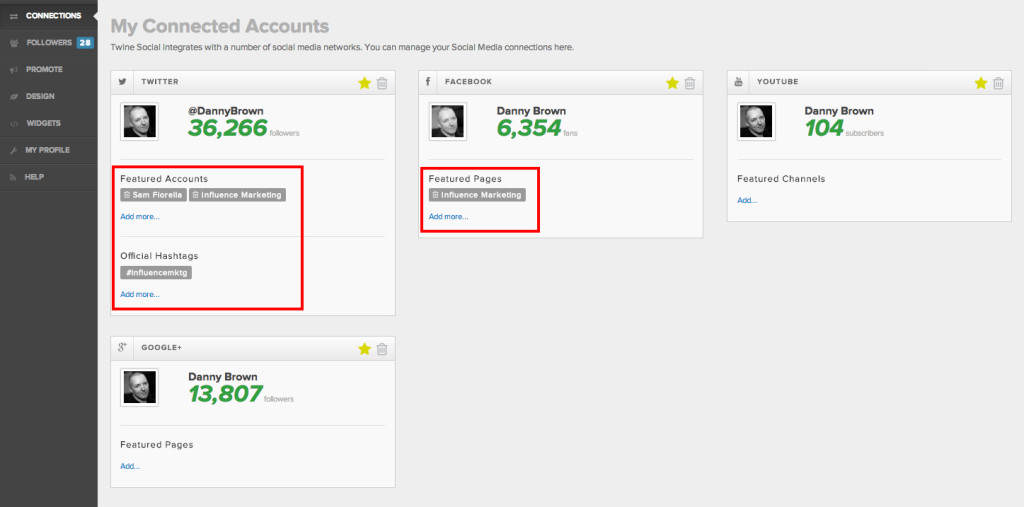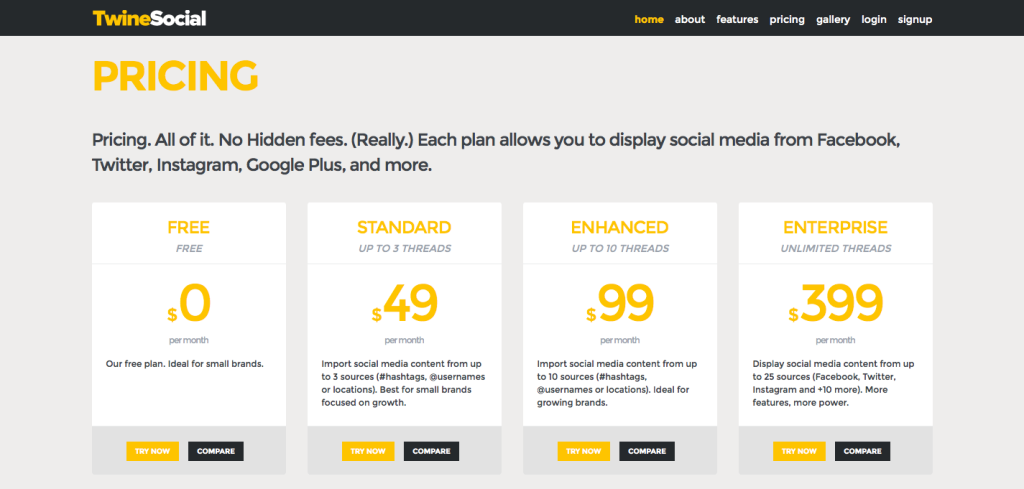TwineSocial and Rich (Social) Media
Anyone can create a social hub. There have been countless examples already – some excellent (RebelMouse and Keyhole, which I’ll be looking at soon), some not so much. However, RebelMouse is more geared towards personal content curation - TwineSocial, on the other hand, is about the integrated experience.
Connecting Your Social Graph
When you first create your TwineSocial account, the first thing you’ll need to do is connect your various social accounts. However, instead of simply connecting your Facebook, Twitter and other standard accounts, you can also select hashtags and search terms around your brand.
As well as the usual suspects, TwineSocial also supports Vine, Vimeo, Flickr and other networks that usually get bypassed by many other curation solutions.
The ability to include hashtags as well as multiple accounts and RSS feeds enables you to create the complete picture around you or your business. Not only that, but peers and colleagues/internal teams can be integrated as well.
The TwineSocial Brand Ecosystem
For example, in my account settings, I have my own standard inclusions – my Twitter account, Facebook, Google+, etc. I also have the #influencemktg hashtag,which my Influence Marketing book co-author Sam Fiorella and I use to continue the influence discussion outlined in the book.
Speaking of Sam, I can feature his account as one of interest, via the TwineSocial Connections feature. This essentially allows the curator to highlight social accounts, people, brands or topics they feel would be interesting to their own social graph.
This Connection feature is available across your chosen social accounts, so if your business has multiple sales teams based on demographic and locale, or your company blog is broken into various sub-sections for your company’s products, you can highlight these different channels as part of your bigger corporate picture.
Or, as a content creator, blogger, podcaster or otherwise, you can bring any other content you own into the fold as recommended channel partners. Or feature the accounts of your podcast guests, etc.
Highlighting Your Key Content
Depending on the size of your business, or how much content you create (or contribute to) as part of your content strategy, your latest stories or updates could potentially be lost soon after they’re published.
To counter that, TwineSocial offers a Pin option. Much like its almost-namesake, this enables a Pinterest-like feature that allows you to keep the most important content front and centre at all times.
Not only that, but when a visitor to your hub selects a particular piece to dig deeper into, it expands into a feature area, while still keeping your live feed behind it.
This offers two benefits – you can choose which content is the one driving the most interest, based on your goals for that period, and you can cross-promote not only your own content, but channel partners for joint promotions.
For example, your content could be the lead hub, your channel partners could be the related products or services surrounding the lead hub. This kind of flexibility could be key in differentiating your product offering in a more visually appealing way than your competitors.
Twine Social – The Verdict
I’ll be the first to admit, I love the direction TwineSocial is taking. The user interface is clean, uncluttered and very easy to navigate – something some of the other hubs have struggled to accomplish.
Additionally, TwineSocial is placing emphasis on the visual appeal of all your content, not just the rich media that you use for an article, blog post or video. The layout of the hub is slick, and the bold images and typography catches the eye of visitors to the hub.
I can see this being used by all kinds of content creators. Brands are obvious, as are producers of multiple content – text bloggers that also use video, for example, or graphic-heavy content (designers, for example).
The cost is attractive too, with plans for all pockets and budgets.
The free version is a great starting point for anyone looking to try the product, while the full-on Enterprise solution offers the promotion of other accounts, white labeled / no TwineSocial branding, custom CSS to replicate your own brand identity, and more. For $399 per month, it could be a great way to collate a brand’s social activity and use to entice new employees, clients, partners and more.
It’s not perfect, though.
On Making Twine Social Even Better
At the moment, it doesn’t offer any analytics around the effectiveness of the hub. For example, it’d be great to see which areas of the hub are garnering the most eyeballs or clicks; it’d also be great to see which parts of the hub drove traffic to a landing page, or which one was shared the most. This would allow you to tailor the hub content more efficiently.
Additionally, it’d be great for visitors to be able to visit a hub and embed a specific section.
So, let’s say I’m writing a piece on social analytics software. I could go to a hub for something like Pulse Analytics, grab a section that compares solutions and their impact on ROI, and embed that directly to my post. If anyone clicked on the embed in my post, it would take them to the Pulse Analytics hub, and all the data the visitor is clearly interested in.
It also uses Klout scores as a measurement of who your most influential followers are – the less said about that, the better..! ![]()
There are also some bugs in the current build. For example, I had issues trying to grab the embed code for my hub to embed it in a page on this blog, to show you what it looks like when integrated with your other content. Additionally, when you add new social accounts, it pulls all of that content to the top of the hub, as opposed to dropping it in by date of the content itself.
However, analytics is on the way, and the embed option is something Aaron Fessler, CEO of TwineSocial, agreed could be a cool feature addition in future iterations when I spoke with him recently about the product. And bugs are always to be expected on beta products (as long as they’re ironed out in future updates).
In the meantime, as I mentioned I am liking the direction and simple approach TwineSocial is taking. As content continues to be an important part of the marketing landscape moving forward, the more your content stands out, the more opportunities should come your brand’s way.
TwineSocial offers that stand out effect in spades.
Disclosure – I was given full access to the Enterprise solution in order to evaluate TwineSocial’s feature set. However, all opinions are mine. You can check out TwineSocial for yourself here.






